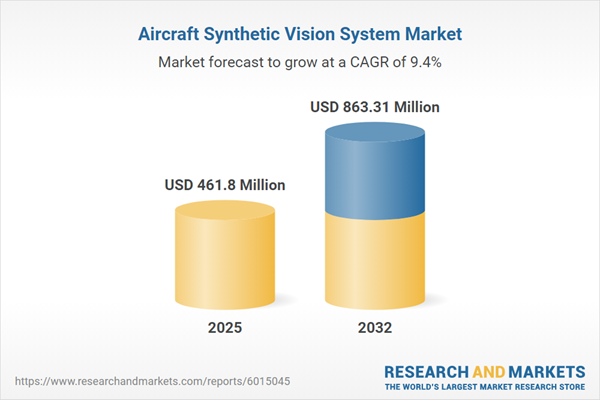Speak directly to the analyst to clarify any post sales queries you may have.
The Aircraft Synthetic Vision System Market is transforming cockpit operations and enhancing aviation safety, supporting decision-makers as they modernize fleets and align with evolving global standards.
Market Snapshot: Aircraft Synthetic Vision System Market Overview
In 2024, the Aircraft Synthetic Vision System Market was valued at USD 422.22 million and is forecast to reach USD 461.80 million by 2025, with long-term expansion projected to USD 863.31 million by 2032 at a CAGR of 9.35%. Consistent investments across commercial, defense, and business aviation segments are reinforcing market growth as operators upgrade avionics to meet new safety mandates. North America and Europe drive intensive technology integration, while Asia-Pacific and EMEA benefit from regulatory shifts and infrastructure development. This landscape points to sustained industry advancement and heightened adoption of modern cockpit solutions globally.
Scope & Segmentation: Synthetic Vision System Market Adoption
- Platform Type: Synthetic vision systems are utilized in both fixed wing and rotary wing aircraft, including commercial jets, business planes, cargo carriers, and helicopters, extending the technology’s benefits across diverse operational scenarios.
- Installation Type: The market includes OEM installations and retrofits, providing flexible options for new aircraft integration or upgrades to active fleets, streamlining modernization for various operator needs.
- Application: Adoption spans business aviation, charter operators, major commercial carriers, and the military, delivering flexibility in fleet application and operational execution.
- Component: Solutions feature technologies such as head-up and head-down displays, and incorporate advanced sensors, including infrared and optical units, paired with specialized cockpit software to boost pilot situational awareness.
- Technology: Both 2D and advanced 3D synthetic vision solutions are available, enabling tailored enhancements in situational awareness based on specific mission and operational needs.
- Geography: Leading adoption is observed in the Americas, with rapid growth underway in Asia-Pacific due to ongoing modernization initiatives and shifting regulatory frameworks. EMEA mirrors this trend, driven by escalating investment in aviation system upgrades and regulation-driven changes.
- Key Companies: Industry participation includes established firms such as Collins Aerospace, Honeywell International, Garmin, Thales, Elbit Systems, L3Harris Technologies, Leonardo, Avidyne Corporation, Universal Avionics Systems Corporation, and Genesys Aerosystems. These organizations offer modular product lines designed to meet varying operational and fleet mix requirements.
Key Takeaways for Senior Decision-Makers
- Modernization strategies support progressive upgrades for both newly manufactured and existing fleets, ensuring readiness for shifting regulatory and industry requirements.
- Operators can implement active system enhancements using modular hardware and upgradeable software, allowing for incremental capability additions with minimal impact on flight schedules.
- Retrofit pathways enable operators to balance budget considerations and operational efficiency goals, extending the useful life of legacy aircraft while expanding access to current-generation technologies.
- Collaboration between avionics, sensor, and software suppliers enables tailored system integration suited to regional, regulatory, and mission-specific needs, improving alignment and operational flexibility.
- Regulatory consistency and harmonization efforts across regions facilitate easier multi-jurisdictional compliance and streamline safety assurance across varied fleets.
- Differing rates of technology adoption across regions highlight the ability of synthetic vision solutions to meet diverse modernization objectives, from fast-track implementation to phased upgrades in established markets.
Tariff Impact: Navigating Trade and Sourcing Challenges
Tariffs on avionics components, including sensors and display modules, have elevated the importance of agile supply chain management. In response, manufacturers are strengthening local sourcing networks and working closely with research partners to safeguard component availability and alleviate cost pressures. Retrofit projects in particular have become more sensitive to supply disruptions, making adaptability and local partnerships key to controlling overall program costs and maintaining delivery timelines.
Methodology & Data Sources
This analysis combines direct interviews with aircraft manufacturers, avionics engineers, and regulatory compliance experts, integrating perspectives from pilot and support teams. Additional market intelligence is drawn from verified industry reports and technical literature, ensuring comprehensive and well-substantiated findings.
Synthetic Vision System Market: Why This Report Matters
- Delivers actionable market intelligence to guide cockpit modernization strategies focused on compliance and operational safety improvements.
- Enables executive-level decisions based on detailed insights into adoption dynamics, supplier activities, and effective planning for sustainable fleet upgrades.
- Clarifies technological and regulatory trends, providing clarity on certification pathways and digital innovation to support organizational agility.
Conclusion
A clear perspective on the Aircraft Synthetic Vision System Market empowers leaders to adapt strategies, respond to regulatory demands, and position operations for continued growth and excellence in aviation.
Additional Product Information:
- Purchase of this report includes 1 year online access with quarterly updates.
- This report can be updated on request. Please contact our Customer Experience team using the Ask a Question widget on our website.
Table of Contents
3. Executive Summary
4. Market Overview
7. Cumulative Impact of Artificial Intelligence 2025
Companies Mentioned
The companies profiled in this Aircraft Synthetic Vision System market report include:- Collins Aerospace Inc.
- Honeywell International Inc.
- Garmin Ltd.
- Thales S.A.
- Elbit Systems Ltd.
- L3Harris Technologies, Inc.
- Leonardo S.p.A.
- Avidyne Corporation
- Universal Avionics Systems Corporation
- Genesys Aerosystems, Inc.
Table Information
| Report Attribute | Details |
|---|---|
| No. of Pages | 186 |
| Published | November 2025 |
| Forecast Period | 2025 - 2032 |
| Estimated Market Value ( USD | $ 461.8 Million |
| Forecasted Market Value ( USD | $ 863.31 Million |
| Compound Annual Growth Rate | 9.3% |
| Regions Covered | Global |
| No. of Companies Mentioned | 11 |









